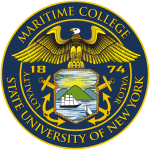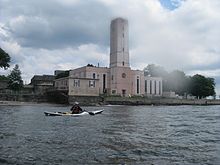
Maritime transport or more generally waterborne transport, is the transport of people (passengers) or goods (cargo) via waterways. Freight transport by sea has been widely used throughout recorded history. The advent of aviation has diminished the importance of sea travel for passengers, though it is still popular for short trips and pleasure cruises. Transport by water is cheaper than transport by air or ground, but significantly slower for longer distances. Maritime transport accounts for roughly 80% of international trade, according to UNCTAD in 2020.

The United States Merchant Marine is an organization composed of United States civilian mariners and U.S. civilian and federally owned merchant vessels. Both the civilian mariners and the merchant vessels are managed by a combination of the government and private sectors, and engage in commerce or transportation of goods and services in and out of the navigable waters of the United States. The Merchant Marine primarily transports domestic and international cargo and passengers during peacetime, and operate and maintain deep-sea merchant ships, tugboats, towboats, ferries, dredges, excursion vessels, charter boats and other waterborne craft on the oceans, the Great Lakes, rivers, canals, harbors, and other waterways. In times of war, the Merchant Marine can be an auxiliary to the United States Navy, and can be called upon to deliver military personnel and materiel for the military.
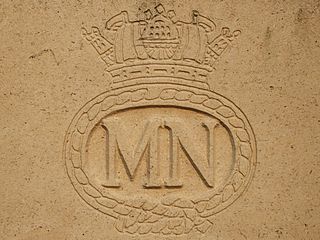
The British Merchant Navy is the collective name given to British civilian ships and their associated crews, including officers and ratings. In the UK, it is simply referred to as the Merchant Navy or MN. Merchant Navy vessels fly the Red Ensign and the ships and crew are regulated by the Maritime and Coastguard Agency (MCA), a specialist agency of the UK Department of Transport. British merchant ships are registered under the UK or Red Ensign group ship registries. British Merchant Navy deck officers and ratings are certificated and trained according to STCW Convention and the syllabus of the Merchant Navy Training Board in maritime colleges and other training institutes around the UK.
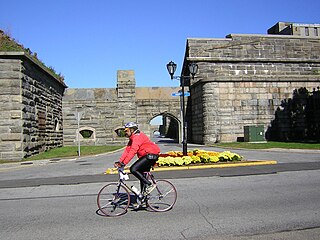
Fort Schuyler is a preserved 19th century fortification in the New York City borough of the Bronx. It houses a museum, the Stephen B. Luce Library, and the Marine Transportation Department and Administrative offices of the State University of New York Maritime College. It is considered one of the finest examples of early 19th century fortifications. The fort was named in honor of Major General Philip Schuyler of the Continental Army.

The United States Merchant Marine Academy is a United States service academy in Kings Point, New York. It trains its midshipmen to serve as officers in the United States Merchant Marine, branches of the United States Armed Forces and the transportation industry. Midshipmen are trained in different fields such as marine engineering, navigation, ship's administration, maritime law, personnel management, international law, customs, and many other subjects important to the task of running a large ship.

The California State University Maritime Academy is a public university in Vallejo, California. It is part of the California State University system and the only maritime academy on the contigious West Coast. The university offers six bachelor's degree programs and one master's degree program.

A chief mate (C/M) or chief officer, usually also synonymous with the first mate or first officer, is a licensed mariner and head of the deck department of a merchant ship. The chief mate is customarily a watchstander and is in charge of the ship's cargo and deck crew. The actual title used will vary by ship's employment, by type of ship, by nationality, and by trade: for instance, chief mate is not usually used in the Commonwealth, although chief officer and first mate are; on passenger ships, the first officer may be a separate position from that of the chief officer that is junior to the latter.
A second mate or second officer (2/O) is a licensed member of the deck department of a merchant ship holding a Second Mates Certificate of Competence, by an authorised governing state of the International Maritime Organization (IMO). The second mate is the third in command and a watchkeeping officer, customarily the ship's navigator. Other duties vary, but the second mate is often the medical officer and in charge of maintaining distress signaling equipment. On oil tankers, the second mate usually assists the chief mate with the cargo operations.

A third mate (3/M) or third officer is a licensed member of the deck department of a merchant ship. The third mate is a watchstander and customarily the ship's safety officer and fourth-in-command. The position is junior to a second mate. Other duties vary depending on the type of ship, its crewing, and other factors.

Massachusetts Maritime Academy is a public university in Buzzards Bay, Massachusetts, focused on maritime-related fields. It was established in 1891 and is the second oldest state maritime academy in the United States. Originally established to graduate deck and engineering officers for the U.S. Merchant Marine, the academy has since expanded its curriculum. Though not required, some graduates go on to serve in active and reserve components of the U.S. Armed Forces. The academy operates a training ship, the USTS Kennedy.
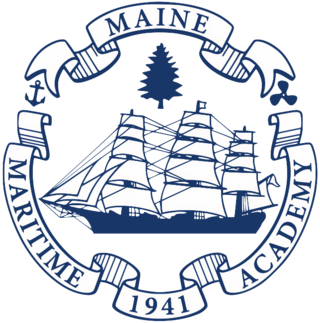
Maine Maritime Academy is a public college focused on maritime training and located in Castine, Maine. The academy was established by the 90th Maine Legislature on March 21, 1941. Unlike federal service academies, a congressional recommendation is not required to attend this state school. Students are not obligated to go to sea or into the military after graduation, and a large portion of the graduating class chooses shore-side employment, often in maritime-related fields or the power generation industry.
Leroy John Alexanderson was the last captain of the SS United States, the largest ocean liner ever built in the United States and the fastest ocean liner in history. Alexanderson also served as Commodore of the United States Lines fleet.

Captain James Harvey Tomb served as superintendent of the New York State Merchant Marine Academy and was appointed the first superintendent of the United States Merchant Marine Academy on April 15, 1942.

The United States Maritime Service (USMS) was established in 1938 under the provisions of the Merchant Marine Act of 1936 as voluntary training organization to train individuals to become officers and crewmembers on merchant ships that form the United States Merchant Marine per 46 U.S.C. § 51701. Heavily utilized during World War II, the USMS was largely dissolved in 1954, and its resources were absorbed into other federal departments. However, while the service is no longer structurally organized, remnants of the service still exist today and the service still actively commissions officers to function as administrators and instructors at the United States Merchant Marine Academy and the state maritime academies.
The maritime history of the United States is a broad theme within the history of the United States. As an academic subject, it crosses the boundaries of standard disciplines, focusing on understanding the United States' relationship with the oceans, seas, and major waterways of the globe. The focus is on merchant shipping, and the financing and manning of the ships. A merchant marine owned at home is not essential to an extensive foreign commerce. In fact, it may be cheaper to hire other nations to handle the carrying trade than to participate in it directly. On the other hand, there are certain advantages, particularly during time of war, which may warrant an aggressive government encouragement to the maintenance of a merchant marine.
USTS Empire State VI (T-AP-1001), callsign KKFW, IMO number 5264510, was a troop ship of the United States Navy and training vessel of the United States Maritime Service.
The New York Maritime Regimental Pipe & Drum Corps is a pipe band made up of officers and cadets of the SUNY Maritime College located in Fort Schuyler, New York. New York Maritime is one of only two pipe bands representing the United States Merchant Marine, the other being the Maine Maritime Pipe & Drum Corps.
Commodore John William Anderson was the longest serving captain of the SS United States, the fastest ocean liner in history. In 1952, he relieved Commodore Harry Manning as master of the superliner after the recordbreaking voyage on which she broke the translantic speed record previously held by the RMS Queen Mary and captured the Blue Riband for the United States.
Felix Riesenberg was an American maritime officer and writer of maritime professional, historical, and fictional literature in the early 20th century.

A sailor, seaman, mariner, or seafarer is a person who works aboard a watercraft as part of its crew, and may work in any one of a number of different fields that are related to the operation and maintenance of a ship.
